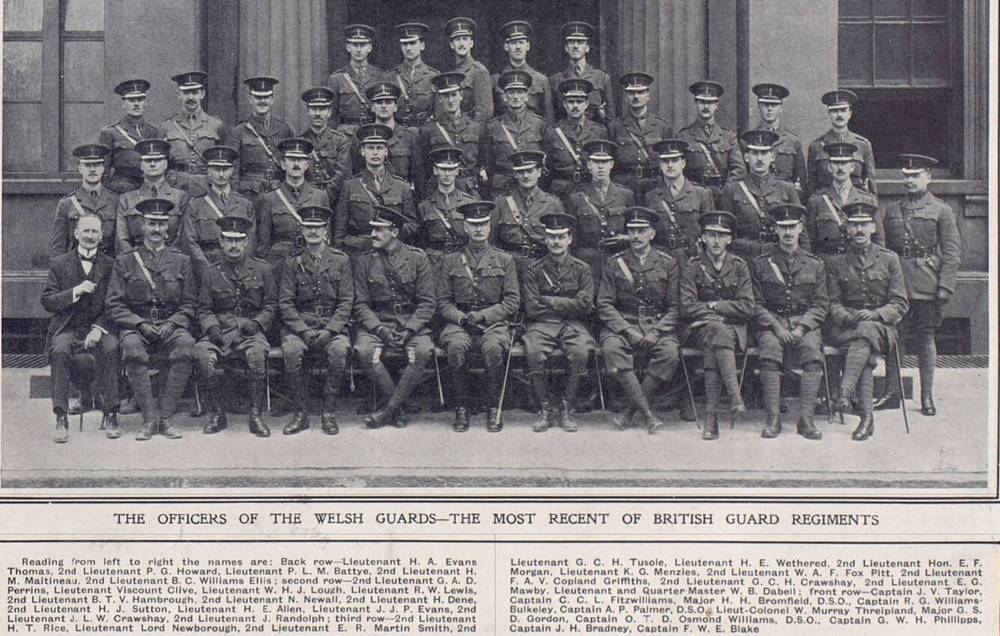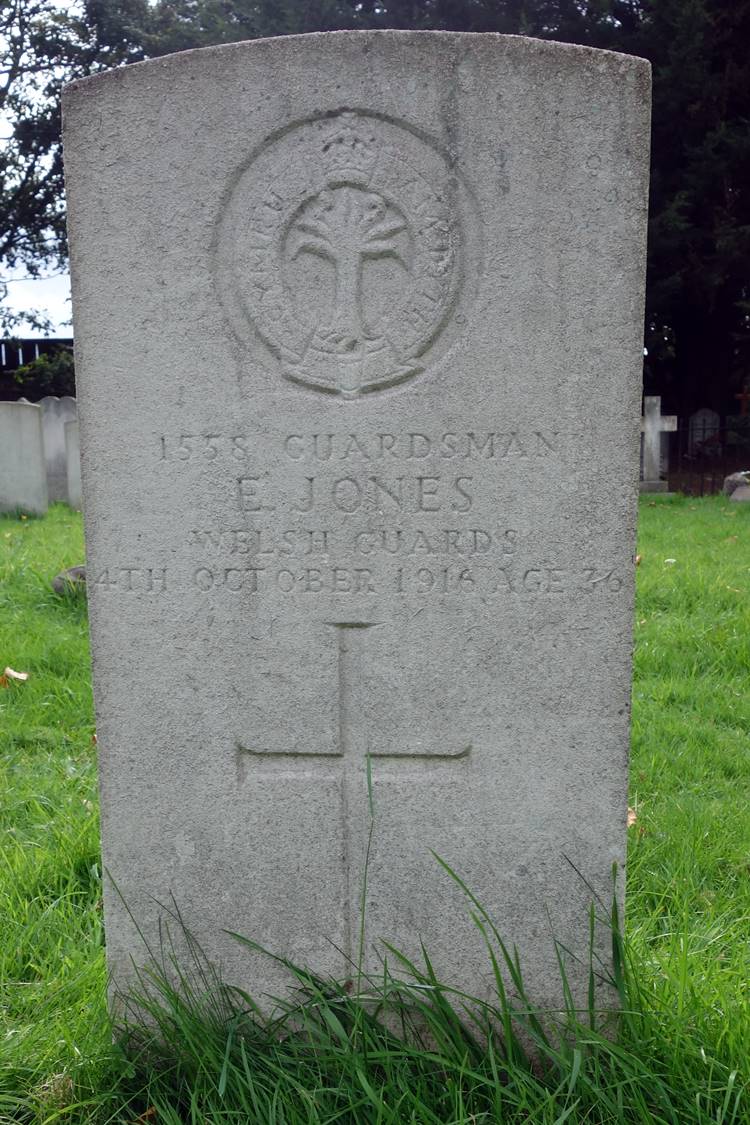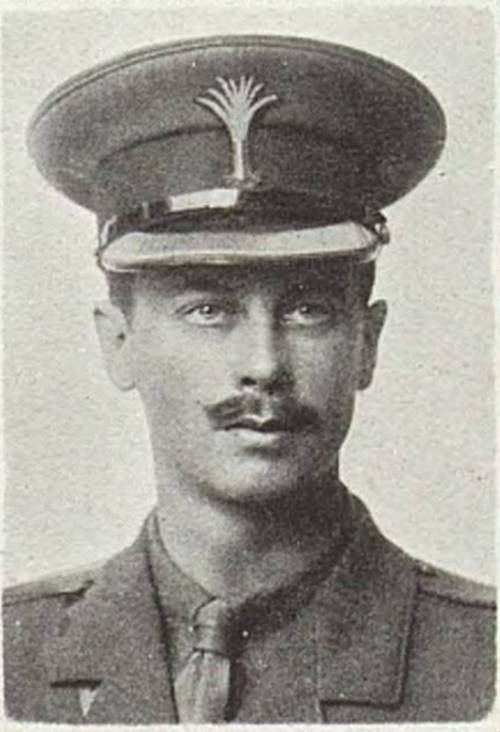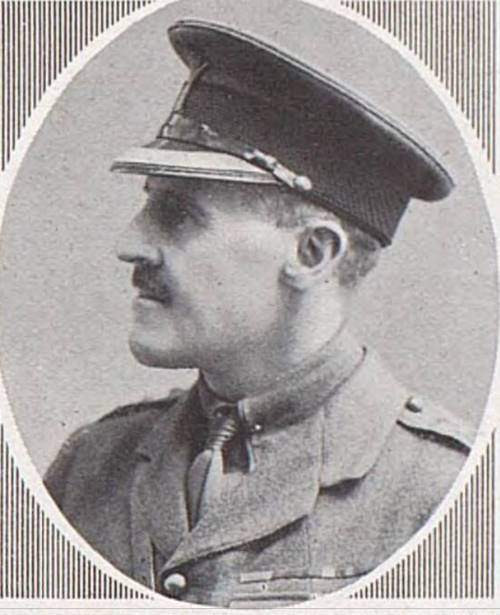This article looks at the service of the Welsh Guards during the First World War and will help you to research those who served with the Regiment. This is one of a series of guides I have created to help you research soldiers who served in the British Army:
The Welsh Guards in the First World War
Captain Hume Buckley Roderick who was killed in action on 1 December 1917 aged 30 and is buried in Gouzeaucourt New British Cemetery. When the Regiment was formed in 1915, a leek, the national symbol of Wales, was chosen for the Welsh Guards’ cap badge.
The Welsh Guards was created by Royal Warrant on 26 February 1915 and is the youngest of the five regiments of Foot Guards. The task of raising the Battalion was given to Major William Murray Threipland of the Grenadier Guards. Volunteers were called for from the other Foot Guard regiments with 200 Welsh recruits undergoing training with the Grenadier Guards at Caterham joining. The Battalion initially trained at White City in London, before moving to Sandown Park in April and then to Wellington Barracks, London in June. In August 1915, the Battalion landed in France. I would recommend anyone wishing to learn more about the Welsh Guards on the Western Front to download the Regiment’s war diary and view a copy of History of the Welsh Guards by Charles Humble Dudley-Ward which I have discussed below.
The Welsh Guards landed at Havre, France on 18 August 1915 and served as part of the 3rd Guards Brigade in the Guards Division for the duration of the war. The Regiment only served on the Western Front and was constantly in action. The Welsh Guards first saw action at Loos on 27 September 1915 where the Regiment suffered heavy casualties. This battle was the start of constant fighting which saw the Welsh Guards awarded over twenty battle honours in three years. The Commonwealth War Graves Commission records the names of 879 officers and men of the Regiment who died during or shortly after the war.
A 2nd Reserve Battalion was formed at Wellington Barracks, near Buckingham Palace in August 1915 but did not see active service. The purpose of this Battalion was to train drafts for the 1st battalion and as a place to send men who weren’t fit enough to rejoin the Battalion in France after being invalided back to Britain. The work of the 2nd Battalion is covered in a short chapter in History of the Welsh Guards.
Researching Soldiers who Served in the Welsh Guards
Welsh Guards’ service records can now be ordered through the Ministry of Defence, as the Regiment no longer holds them. You can apply for them here: Order Welsh Guards Service Records. For First World War soldiers, you do not need a death certificate or permission of the next of kin. If you’re researching either an officer or other rank who served with the Welsh Guards then you’re in luck as there’s usually a lot more information available for this Regiment than most. Start off by looking at my generic guides, especially those relating to medal records: Researching Soldiers who served in the British Army. You will need to search both Ancestry and FindmyPast to make sure you gather all available resources for a soldier. Both sites offer free trials and clicking on the banner below will take you to FindmyPast. I’d recommend downloading both the war diary and History of the Welsh Guards by Charles Humble Dudley-Ward which I have discussed below.
Researching Officers: Officers who served in one of the Guards Regiments are usually easy to research and the Welsh Guards is no exception. A service record is the most important document to find, so first check to see if one is held at the National Archives which holds over 100: Welsh Guards files held at the National Archives. The regimental history contains an appendix summarising the services of officers of the Regiment and many are mentioned throughout the book. There are also many pen portraits of officers. If there’s no service record at the National Archives and the officer served past April 1922, then you’ll need to apply for a copy of their service record from the Ministry of Defence. For a First World War officer, you do not need a death certificate or the permission of the next of kin.
Researching Other Ranks: A service record is the key document and these are held by the Ministry of Defence. You do not need a death certificate or the next of kins’ permission to apply for a First World War soldiers’ record. FindmyPast has transcribed the nominal roll of other ranks who served on the Western Front during the war which is found as an appendix in the regimental history. The regimental history also contains a large number of other ranks mentioned throughout the text. If you don’t want to order a soldier’s service record, then medal records, casualty lists and newspaper reports will often yield a lot of information.

War Diary of the Welsh Guards
There is only one war diary for the Welsh Guards which has been digitized by the National Archives and can be downloaded for a small fee by clicking on the blue link below. A war diary was a unit’s record written by an officer which recorded its daily activities and location. They are usually the most important documents for researching a unit during the First World War.
- Date: 17 August 1915 – 28 February 1919
- 3rd Guards Brigade, Guards Division
- Reference: WO 95/1224/1
- Notes: An excellent war diary which totals over 500 pages and includes a wide variety of appendices including many accounts of the Welsh Guards in action. Officers are named throughout. If only every unit kept such a detailed war diary.
Regimental History of the Welsh Guards
There is an excellent regimental history: History of the Welsh Guards by Charles Humble Dudley Ward which has been reprinted by the Naval and Military Press and is also available to view and download for free online. This history is crammed full of the names of officers and men who served with the Welsh Guards along with detailed accounts of the battles the Regiment was involved in. The history contains maps, photographs and eleven appendices including a nominal roll of all the officers and men of the Welsh Guards who served overseas. The regimental history is full of snippets like the paragraph below:
Sergt. Manuel, of No.4 Company, was out of the line with boils for some considerable time. He was a very gallant and cheerful fighter. Sergt. Trott had been in the line for six weeks on end, during which he had not seen Manuel. When the battalion went out to rest these two worthies met. “I have got something interesting to show you,” said Trott, and produced an ordinary looking round of ammunition which he held up in front of Manuel’s nose. “This” he explained, “is what we use in the line to kill Germans – we call it a ’round.’ Want to keep it as a souvenir”.
Click on the link below to view and download the book for free:
History of the Welsh Guards Online
Further Sources for the Welsh Guards
Charles Humble Dudley-Ward, who wrote the regimental history, kept a detailed journal of his service with the Regiment. Totalling over 850 pages and spanning six volumes, this important resource can be viewed at the Imperial War Museum: Documents.6374. I haven’t seen Dudley-Ward’s journals but they are described as an outstanding resource in the catalogue. After the war diary, this is probably the most important source relating to the Regiment during the First World War.
There is a two-volume History of the Guards Division in the Great War by Cuthbert Headlam which is useful for putting the 1st Battalion’s role in context within both the 3rd Guards Brigade and Guards Division. There are maps containing the Division’s boundaries during major attacks which can save a lot of time in trying to work out where units were operating.
Extracts from the War Diary of the Welsh Guard
Below is part of the letter written by Lieutenant-Colonel William Murray Threipland describing the Battalion’s first action at Loos on 28 September 1915. The attack was a disaster and the 3rd Brigade of Guards suffered heavy casualties.
Letter from Colonel Murray Threipland dated September 28th [1915]
My dear Colonel,
I will now let you know particulars of our first fight. Yesterday afternoon I got verbal orders followed by written orders that an attack was to take place by two Brigades of the Guards’ Division. I will not go into particulars of the combined attack, except where it may be necessary in giving you information about this battalion.
I will begin with our casualties, which I fear are heavy: as I know them at present they are 11 officers and 400 non-commissioned officers & men. I very much doubt the officers being below this number, but I hope & think the 400 will be very much reduced when I get more information & men keep coming in.
I should say the behaviour of the Battalion was beyond all praise; they were truly magnificent: no higher trial to discipline was to my mind possible than the experience we went through, & nothing was done which was not absolutely up to the best of Brigade of Guards standard.
Forgive me if I am disjointed, but I have had no sleep since Sunday night, & am much knocked at the Battalion being so cut up. I have great hopes however that our total casualties may be reduced to some 200 or so in all, but at present it is impossible to say, & I only hope.
Captain Arthur Percy Palmer DSO who was killed in action at Loos on 27 September 1915 and was the first officer casualty recorded in Threipland’s list.
First the officers: Killed Palmer, Mawby. Missing, probably killed: Randolph, R. Smith, Sutton. None of above bodies have been recovered yet, being beyond our present line.
Osmond-Williams. Wounded back of neck – I fear bad, as he lay out till this morning & was suffering from shock. Since died.
Philipps. Wounded, stomach, (but not bad) & a finger taken off. He also was out till this morning. Doctor says he is not bad.
Rhys Williams. Slight, bullet in back.
Howard. Slight, damaged knee.
Copland-Griffiths. Slight, flesh wound, & back to duty.
Crawshay. Wounded in arm, high up near shoulder.
We started from where we were bivouacked some 3 miles from here, and a mile down the road had to get into artillery formation & crossed a great open plain for 1 1/2 miles, under heavy shelling, and in full view, obviously, of the German observers. The order of march & attack was:- 4th Battalion Grenadier Guards:, Welsh Guards:, 2nd Battalion Scots Guards:, 1st Battalion Grenadier Guards: The attack was to have been done by 4th Battalion Grenadier Guards: with us in support: it was not expected we should be employed except to take over the line from the 4th Battalion Grenadier Guards: if they were badly knocked about after the attack. The attack was to be shortly after an attack by the 2nd Guards Brigade on our left, and contingent on their occupying successfully certain positions without which our attack would not be feasible: The 2nd Brigade attack to commence at 4 pm.
The 3rd Guards Brigade were to assemble in a town 2 hours before the attack commenced, & Brigadier & commanding officers of 4th Grenadiers & Welsh Guards were to make a personal reconnaissance. Written orders were subsequently issued by the Brigade at 1.40 to march in above order at 2.
We were ready to do so: the 4th Battalion were late, and we did not march till 2.30. I was to report at a certain place in the town to the Brigadier, after forming up battalion in a suitable place. After marching about 1 mile we came under artillery fire, and whole brigade advanced in artillery formation across an open plain, sloping to the town on our front. This advance covered from 1 mile to 1 1/2 miles, during the whole of which time we were very heavily shelled by shrapnel and explosive, also under enfilade Maxim for about 40 yards.
Nothing I can say would represent what I feel at the behaviour of the battalion & the leading of every officer during this very trying time. There was no disorder, & every platoon appeared to me to be in its place, & advancing quietly and in excellent order. We were rather unnecessarily delayed by the last company of the Grenadiers, under a very young officer, who got in the way & lost touch with his battalion.
It was obvious from the heavy shelling which we were undergoing, and which was falling in the town, that any attempt at falling in the battalion for attack, as had been anticipated, was out of the question. We were fortunate in coming on a large trench between us and the town, into which I turned the battalion while I went forward to reconnoitre for the Brigadier, who I was most fortunate in finding fairly soon. He told me Gilbert Hamilton, Grenadiers, had been heavily gassed, & was unfit for duty. The battalion had got scattered, and a considerable portion of it was lost. The Brigadier gave me orders to bring up my battalion, and, along with what remained of the Grenadiers, to arrange & carry through the attack on Hill 70.
Having got my battalion along the trench to a suitable street to arrive at my jumping off place, where I found 4th Battalion Grenadier Guards under Miles Ponsonby in some light trenches, south of the town. He told me he had only some 200 men. I arranged to attack the position the Grenadiers directing on the left, my Prince of Wales’ Company with a frontage of 2 platoons prolonging to the right of the Grenadiers: my No. 3 Coy supporting Grenadiers: my No.2 supporting Prince of Wales’: No.4 Coy I kept in hand.
I launched my attack at 5.30 pm, the Brigadier having told me the 2 essential positions on our left had been taken by the 2nd Guards’ Brigade.
I informed the Brigadier of the launching & time of the attack and heard shortly after from my liaison officer with the brigade, that before my order to attack had arrived, the Brigadier had found that the attack of the 2nd Brigade had failed, and had sent me orders to cancel my attack. As these orders had not however left the Brigade office, and the attack had commenced, the cancellation order was destroyed.
I was then for some time without any information: darkness came on in less than 1/2 an hour of my attack, & I received no artillery support, but equally had no artillery fire on me, the enemy confining themselves to the shelling of the town and the ground where the other two battalions of the 3rd Brigade were still crossing in Artillery formation.
The rifle fire on my front was heavy, but from what I could make out, not much return fire by us, which was satisfactory, as darkness was on and the advance & bayonet was the thing. The information not arriving disturbed me for two reasons; first, that I had no information of the progress of the attack, & secondly, as I felt sure captains would have sent information if possible, it tended to show that some or all of them were casualties. At last Menzies arrived from No.2 to say that he had spoken to a messenger from Bulkeley on his way back to me. The messenger had got hurt & could not come on and he had brought the message which have me information that the company had got on the hill & could get no further without reinforcements, and that many casualties had occurred. They were safe where they were, being under a bank, but anyone advancing beyond was shot.


